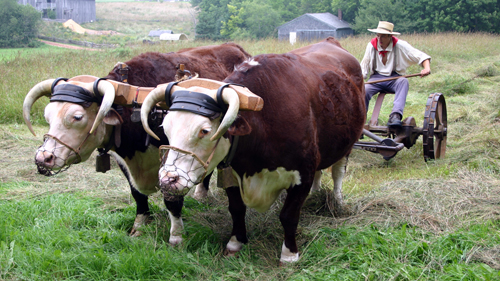Oxen Did Heroic Work on the Bush Lot Farms of the Pioneers

They Did the Heavy Work Better Than Horses Could Were Steady, Reliable and Strong – Could be Easily Trained – Were Able to Scent Water a Mile Away.
A Nonagenarian’s Story
When the late Noble Watterson and his family went into North Gower in the year 1844 from Ireland, he took with him a yoke of oxen. Those oxen played a big part in the work of conquering the wilderness. When it came to pulling stumps and hauling logs the oxen were stronger and steadier than the horses and easier to feed, as they could live on food that horses could not eat.
Mr. Watterson believes his father had the first yoke of oxen that went into their part of the township.
Short on Feed
For example, prior to the land being cleared, all the oxen had to eat were the leaves of the basswood trees. In the summer Noble Watterson and his 14-year-old son would chop down basswood trees in the forest and let the oxen “go to it,” or in other words, feed themselves off the green leaves.
Gathered Leaves
In the fall they would gather a large quantity of green basswood leaves, dry them, powder them and store them away. For the first winter or two, the poor oxen had to exist on the dried leaves alone mixed into a mash, into which had been mixed such scrapings as came from the household table. After the first few years, when winter came they would combine the leaves with a small quantity of oats and cut up a few potatoes to make feed.
Good When Trained
In later years when the land was cleared a bit, the oxen ate grass in the summer. In the winter they ate such crop stuffs as the farm then produced.
Mr. William Watterson, the son, who is now 98 and living at 136 First Avenue, says that once a yoke of oxen were trained into ploughing or other farm work they proved more reliable than horses. Mr. Watterson says that with a yoke of oxen he has ploughed furrow much straighter than with horses.
While oxen did not require the care horses did, they were, of course, slow. Painfully slow, especially when going to or coming from town, but they were also sure.
Nose for Water
A thing about oxen which Mr. William Watterson vividly recalls is the uncanny nose they had for water. When travelling to or from town, if the oxen got thirsty and there was water ahead, they could smell it for a mile or two away, and could not be held back. If the water was off the road in the bush, they had to be unharnessed and let go in after it, or they would try to take cart and everything with them in an effort to get into the bush.
Landed at Lindsay's
The Wattersons landed at Bytown in the spring of the year on their way to North Gower. From Bytown they took a steamboat up the Rideau to Lindsay's wharf (at Kars), and from there slashed a road part of the way through the bush to their farm The path cut was zig-zag in order to escape the swamp lands. In that part of the country but few natural open spaces or groves were found. It was all solid bush.
(This article originally appeared in the Ottawa Citizen, July 6, 1929)
